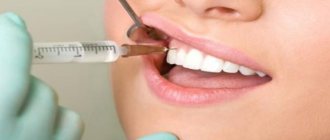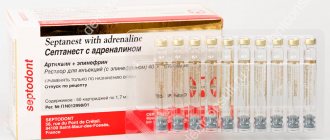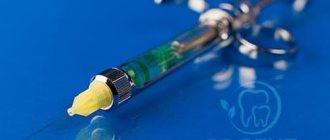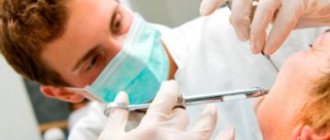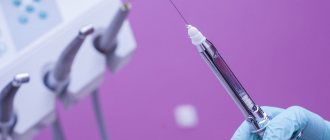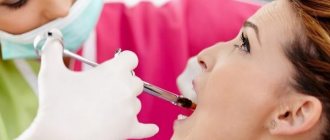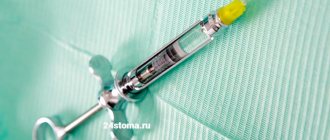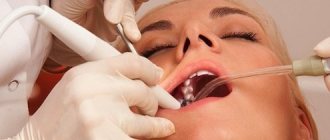Artikain
Articaine is a clear, colorless or yellowish solution for injection.
Indications for use: Infiltration and conduction anesthesia in dentistry. The drug is optimal when working with patients with a history of allergies, in gerontological and pediatric dentistry, and in patients with cardiovascular diseases. The onset of pain relief is from 1 to 3 minutes. Effective anesthesia time is at least 20 minutes. It is possible to prolong anesthesia by injecting the anesthetic.
Analogue of the drug: Ultracain D
Articaine is a local anesthetic (thiophene derivative) for infiltration and conduction anesthesia in dental practice, has a pronounced local anesthetic effect. In tissues (in a slightly alkaline environment) it undergoes hydrolysis and releases a base that has lipophilic properties and easily penetrates the membrane into the nerve fiber.
Articaine interacts with receptors, blocks sodium channels in the nerve fiber membrane, thus providing a local anesthetic effect. The effect of the drug begins quickly (the latent period is 1-3 minutes). Duration of action: 20 minutes. The rapid destruction of articaine to an inactive metabolite - articainic acid - is the reason for its very low toxicity, which allows repeated administration of the drug. In an acidic environment the effect is reduced.
Compound:
1 ml of solution contains: active substance: articaine hydrochloride - 40 mg; excipients: sodium chloride – 2.1 mg water for injection up to 1 ml.
Instructions for use
Before administering the drug, it is always recommended to perform an aspiration test in order to avoid intravascular administration of the drug. The pressure on the piston during drug administration should be adjusted depending on tissue sensitivity. Administration of the drug into inflamed areas of the mucous membrane is not recommended. Eating is allowed only after sensitivity has been restored.
For uncomplicated extraction of maxillary teeth in the non-inflammatory stage - 1.7 ml per tooth into the vestibular depot; if necessary, additionally - 1.0-1.7 ml.
For anesthesia for palatal incisions and suturing to create a palatal depot - 0.1 ml.
When removing premolars of the lower jaw (5-5) in an uncomplicated stage, infiltration anesthesia gives the effect of conduction anesthesia.
When preparing cavities and grinding teeth for crowns , with the exception of molars of the lower jaw, a vestibular injection of 0.5 - 1.7 ml per tooth.
When performing one treatment procedure, the maximum dose for adults is 4 mg/kg body weight.
Use during pregnancy and lactation: The safety of Articaine during pregnancy has not been established due to insufficient clinical data. Articaine penetrates the placental barrier. The question of using the drug by a dentist can only be accepted if the potential benefit from its use justifies the potential risk to the fetus. Has no effect on the fetus (except for possible bradycardia) with any technique of application and dose. During lactation there is no need to interrupt breastfeeding, since clinically significant concentrations of Articaine are not found in breast milk.
Contraindications: Hypersensitivity to articaine or other local anesthetic drugs of the amide group; megaloblastic B12 deficiency anemia; angle-closure glaucoma; diseases of the central nervous system; chronic hypoxia; bronchial asthma. Paroxysmal tachycardia; atrial fibrillation; severe cardiac conduction disturbances (for example, atrioventricular block II-III degree, severe bradycardia), acute heart failure, arterial hypotension. Volumetric maxillofacial operations, as well as with intervention durations exceeding 20 minutes. Children under 4 years of age (efficacy and safety have not been studied). With caution: Women in labor with preeclampsia, bleeding in the last trimester of pregnancy.
Articaine, detailed instructions for use
, Russia
Shelf life: 3 years
Articaine, solution for injection 40 mg/ml, ampoules 2 ml No. 10 price: 870.00 rub. (on order)
Articaine 40 mg/ml, cartridges 1.7 ml No. 50 price: RUB 1,820.00
pharmachologic effect
The mechanism is based on the effect on the endings of both sensory nerves and nerve fibers, which creates conditions for disrupting the generation of an exciting impulse and its conduction to other structures. Articaine interacts with receptors that are responsible for the functioning of sodium channels. By influencing them, the flow of sodium ions through them is blocked, as a result of which an anesthetic effect develops.
The duration of action is about 20 minutes. It is destroyed into products that are non-toxic to the body, which makes it possible to re-introduce the substance. In an acidic environment, the effectiveness of the drug decreases.
Articaine with adrenaline (Articaine + epinephrine)
Articaine with adrenaline is a clear, colorless or yellowish solution for injection.
Indications for use: Infiltration and conduction anesthesia during dental operations - uncomplicated removal of one or more teeth, treatment of cavities and grinding of teeth before prosthetics in adults and children over 4 years old. The drug can be used in patients at risk, in childhood (children over 4 years old), and during lactation. Effective anesthesia time is at least 45 minutes.
Analogs: Ultracain DS, Ubistezin, Septanest with adrenaline.
Articaine with adrenaline is a combination drug that contains articaine (an amide-type local anesthetic) and epinephrine (a vasoconstrictor), which is added to the drug to prolong anesthesia.
Articaine is a local anesthetic used for infiltration and conduction anesthesia in dental practice. The amide structure of articaine is similar to that of other local anesthetics, but its molecule contains one additional ester group, which is quickly hydrolyzed by esterases in the human body. The rapid destruction of articaine to its inactive metabolite (articainic acid) is associated with its very low systemic toxicity, allowing repeated injections of the drug. Local anesthetics cause reversible loss of sensation by stopping or reducing the conduction of sensory nerve impulses near the injection site. They have a membrane-stabilizing effect by reducing the permeability of nerve cell membranes to sodium ions.
Articaine with adrenaline has a rapid (latent period from 1 to 3 minutes) and strong anesthetic effect and has good tissue tolerance. The duration of anesthesia is at least 45 minutes. Due to the very low content of epinephrine in the drug, the effect of the latter on the cardiovascular system is insignificant: there is almost no increase in blood pressure and an increase in heart rate.
Articaine with adrenaline composition:
1 ml of solution contains: active ingredients: articaine hydrochloride - 40 mg and epinephrine hydrotartrate - 0.009 mg (in terms of epinephrine - 0.005 mg, which corresponds to the content of epinephrine in the solution 1:200,000);
excipients: sodium disulfite - 0.50 mg, sodium chloride - 1.00 mg, water for injection up to 1 ml.
Articaine with adrenaline: method of administration and dosage
The drug is intended for use in the oral cavity and can only be injected into tissues where there is no inflammation. It is impossible to inject into inflamed tissues. The drug cannot be administered intravenously. For anesthesia for uncomplicated extraction of teeth in the upper jaw in the absence of inflammation, it is usually sufficient to create a depot of Articaine with adrenaline in the area of the transitional fold by introducing it into the submucosa from the vestibular side (1.7 ml of the drug per tooth). In rare cases, an additional injection of 1 ml to 1.7 ml may be required to achieve complete anesthesia. In most cases, this eliminates the need for a painful palatal injection. When removing several adjacent teeth, the number of injections can usually be limited.
For anesthesia for incisions and sutures in the palate to create a palatal depot, about 0.1 ml of the drug is required for each injection.
In the case of removal of mandibular premolars in the absence of inflammation, mandibular anesthesia can be dispensed with, since infiltration anesthesia provided by an injection of 1.7 ml per tooth is usually sufficient. If in this way it was not possible to achieve the desired effect, an additional injection of 1-1.7 ml of anesthetic should be performed into the submucosa in the area of the transitional fold of the mandible on the vestibular side. If in this case it was not possible to achieve complete anesthesia, it is necessary to conduct a conduction block of the mandibular nerve.
When treating cavities and grinding teeth for crowns , with the exception of the lower molars, depending on the volume and duration of treatment, the introduction of Articaine with adrenaline into the area of the transitional fold on the vestibular side in a dose of 0.5-1.7 ml per tooth is indicated.
When performing one treatment procedure, adults can be administered articaine in a dose of up to 7 mg per 1 kg of body weight. It was noted that patients tolerated doses up to 500 mg (corresponding to 12.5 ml of solution for injection) well.
For pediatric patients (over 4 years old), the dose of Articaine with adrenaline is selected depending on the age and body weight of the child, but it should not exceed 5 mg of articaine per 1 kg of body weight.
In elderly patients and all patients with severe renal and hepatic insufficiency, increased plasma concentrations of articaine may occur. For these patients, the minimum doses necessary to achieve a sufficient depth of anesthesia should be used.
To avoid accidental entry of the drug into the blood vessels, before its administration, a two-stage aspiration test should always be performed with the needle rotated 90 and 180 (see detailed instructions).
Severe systemic reactions due to unintentional intravascular administration of the drug can be prevented by slow administration: first inject 0.1-0.2 ml of the drug, then, after 20-30 s, slowly inject the rest of the drug. The injection pressure should correspond to the sensitivity of the tissue.
Contraindications: Hypersensitivity to articaine or to other amide-type local anesthetics, unless in case of hypersensitivity to amide-type local anesthetics, an allergy to articaine has been excluded by appropriate studies conducted in compliance with all necessary rules and requirements. Hypersensitivity to epinephrine; hypersensitivity to any of the auxiliary components of the drug. (see detailed instructions).
Articaine with adrenaline (Articaine + epinephrine), detailed instructions for use
Articaine with adrenaline (Articaine + epinephrine)
, Russia
Shelf life: 2.5 years for cartridges, 3 years for ampoules
Articaine with adrenaline, solution for injection (40 mg+0.005 mg)/ml, ampoules 2 ml No. 10 price: 870.00 rub. (on order)
Articaine with adrenaline 40+0.005 mg/ml cartridges (1:200,000) 1.7 ml No. 50 price: RUB 1,705.00
General information, release form
Articaine was first synthesized in 1969, and its widespread use began in 1976. Nowadays, medications based on Articaine are produced by many pharmaceutical companies.
Basic requirements for local anesthetics:
- significant depth of penetration of the product;
- long duration of action;
- high degree of security.
These parameters are influenced by:
- activity of the anesthetic used;
- peripheral vascular tone.
The drug Articaine does not contain a special preservative - paraben, which most often causes hypersensitivity reactions. Contains a minimal amount of the antioxidant adrenaline (metabisulfite).
The stability of the local anesthetic is achieved through high quality glass, rubber components of the carpule, and high activity of the active substance.
It is insoluble in aqueous media, so it is used in the form of a salt, which is water soluble. For the main effects to manifest, its destruction in tissues is required with the formation of fat-soluble substances that are able to penetrate the lipid membrane of the nerve ending. It undergoes changes in tissue structures quite quickly, so the analgesic effect is noted within 1-2 minutes.
Articaine has a slight ability to expand the lumen of blood vessels, so it is advisable to use it with epinephrine (adrenaline). It quickly penetrates into soft tissues, as well as into bone structures, which ensures a rapid onset of effect, as a result of which it is widely used in therapeutic, surgical, and orthopedic interventions in dentistry.
Available in the form of cartridges and solutions for injection in ampoules. Packed in cardboard boxes.
The drug is intended for use in the oral cavity.
In order to avoid accidental release of the drug into the blood vessels, a two-stage aspiration test should always be performed before its administration, rotating the needle 90 and 180°. The main systemic reactions that may develop as a result of accidental intravascular administration of the drug can be avoided by following the injection technique: after an aspiration test, 0.1 - 0.2 ml of the drug is slowly injected, then, no earlier than 20 - 30 seconds later, slowly injected the remaining dose of the drug. The injection pressure should correspond to the sensitivity of the tissue.
To prevent infection (including with the hepatitis virus), it is necessary to ensure that new sterile syringes and needles are always used when taking the drug from ampoules. Opened cartridges must not be reused for other patients (risk of hepatitis infection)! Damaged cartridges must not be used.
The drug should not be used if it has changed color or becomes cloudy. Dosage regimen
For anesthesia during uncomplicated extraction of teeth of the upper jaw in the absence of inflammation, it is usually sufficient to create a depot of the drug Articaine with adrenaline forte in the area
transitional fold by introducing it into the submucosa from the vestibular side (1.7 ml of the drug per tooth). In some cases, it may be necessary to achieve complete anesthesia.
additional administration from 1 ml to 1.7 ml. In most cases, this eliminates the need for a painful palatal injection.
For anesthesia for incisions and sutures in the palate in order to create a palatal depot, about 0.1 ml of the drug per injection is required.
When removing several adjacent teeth, the number of injections can usually be limited.
In the case of removal of mandibular premolars in the absence of inflammation, as a rule, it is sufficient to administer 1.7 ml of the drug per tooth. If in this way it was not possible to achieve the desired
effect, an additional injection of 1 - 1.7 ml of anesthetic should be performed into the submucosa in the area of the transitional fold of the mandible on the vestibular side.
If in this case it was not possible to achieve complete anesthesia, it is necessary to conduct a conduction block of the mandibular nerve.
During surgical interventions, depending on their severity and duration, the drug Articaine with adrenaline forte is dosed individually.
When performing one treatment procedure, adults can be administered up to 7 mg of articaine per 1 kg of body weight. It was noted that patients tolerated doses up to 500 mg well (corresponding to 12.5 ml of the drug).
Elderly patients and patients with severe renal and hepatic impairment
In elderly patients and all patients with severe renal and hepatic insufficiency, increased plasma concentrations of articaine may occur. For these
Patients should be treated with the minimum dose necessary to achieve a sufficient depth of anesthesia.
Children
- For pediatric patients (over 4 years of age), the minimum doses necessary to achieve adequate anesthesia should be used. The dose of Articaine with adrenaline forte is selected depending on the age and body weight of the child, but it should not exceed 7 mg of articaine per 1 kg of body weight (0.175 ml/kg). The use of the drug in children under 1 year of age has not been studied. Side effect
- The incidence of side effects is presented in accordance with the classification recommended by the World Health Organization: very often (2 1/10); often (2 1/100, < 1/10); uncommon (2 1/1000, <1/100); rare (2 1/10000, <1/1000); very rare (<1/10000), including isolated reports; frequency unknown (cannot be determined from available data). Immune system disorders Not known
- Allergic or allergy-like reactions. They can be expressed in the form of swelling and (or) inflammation at the injection site, but can also occur regardless of the injection site and manifest themselves in the form of redness, itching, conjunctivitis, rhinitis, angioedema of the face with swelling of the upper and (or) lower lip, cheeks, swelling of the larynx with a feeling of a “lump in the throat” and difficulty swallowing, urticaria and difficulty breathing, which can lead to anaphylactic shock.
- From the central nervous system / Often
Paresthesia, hypoesthesia, headache (due to the presence of epinephrine in the drug).
Infrequently
Dizziness.
Frequency unknown
- dose-dependent reactions from the central nervous system (including at excessively high doses or after accidental intravascular injection): anxiety, nervousness, stupor, confusion up to loss of consciousness, coma, respiratory failure up to respiratory arrest, muscle tremors and twitching muscles up to generalized convulsions;
- if the correct technique for administering the drug is violated or due to anatomical features in the injection area, damage to the facial nerve is possible, which can lead to paralysis of the facial nerve and a decrease in taste sensations.
Visual disorders
Frequency unknown
Visual disturbances (blurred vision, mydriasis, blindness, double vision), usually reversible and occurring during or shortly after injection of a local anesthetic.
Articaine with adrenaline forte, solution for injection (40 mg+0.01 mg)/ml, ampoules 2 ml No. 10 price: 870.00 rub. (on order)
Articaine with adrenaline forte 40+0.01 mg/ml cartridges (1: 100,000) 1.7 ml No. 50 price: RUB 1,785.00
Also purchased with this product:
- Dental materials, instruments and equipment
- Articaine INIBSA
- Articaine, Articaine with adrenaline, Articaine with adrenaline forte
- Brilocaine - adrenaline forte
- Cathejell with Lidocaine
- Dental injection kit AERS (disposable carpule syringe+carpule+needle)
- Disposable carpule syringe
- Orabloc®, injection solution
- Primacaine adrenaline
- Septanest with Adrenaline
- Scandinibsa® 3% (Scandinibsa 3%)
- Ultracain DS, Ultracain DS forte
- Ubistezin forte
- Carpule syringe
- Carpule needles
- Lidocaine
Overdose
At the first manifestations of toxic effects, such as dizziness, motor agitation or stupor during drug administration, its administration should be stopped and the patient should be transferred to a horizontal position with the lower limbs raised. The airway should be maintained and hemodynamic parameters (heart rate and blood pressure) monitored. It is always recommended, even if the symptoms of intoxication seem mild, to install an intravenous catheter in order to be able to immediately administer the necessary medications intravenously, if necessary.
In case of breathing problems, depending on their severity, oxygen supply is recommended, and if there are indications for artificial respiration, endotracheal intubation and artificial ventilation of the lungs are recommended.
The administration of centrally acting analeptics is contraindicated.
Muscle twitching and generalized convulsions can be relieved by intravenous administration of short-acting or ultra-short-acting barbiturates. It is recommended to administer these drugs slowly, under constant medical supervision (risk of hemodynamic disorders and respiratory depression) and with simultaneous oxygen supply and monitoring of hemodynamic parameters.
Often, bradycardia or a sharp decrease in blood pressure can be eliminated by simply moving the patient to a horizontal position with the lower limbs elevated.
In case of severe circulatory disorders and shock, regardless of their cause, the drug should be discontinued and the patient should be transferred to a horizontal position with the lower limbs elevated. Oxygen should be supplied, intravenous administration of electrolyte solutions, glucocorticosteroids (250-1000 mg methylprednisolone), if necessary, plasma substitutes, and albumin.
With the development of collapse and increased bradycardia, slow intravenous administration of a solution of epinephrine (0.0025-0.1 mg) under the control of heart rate and blood pressure is indicated. If it is necessary to administer doses exceeding 0.1 mg, epinephrine should be administered by infusion, adjusting the rate of administration under the control of heart rate and blood pressure.
Severe tachycardias and tachyarrhythmias can be stopped by the administration of antiarrhythmic drugs, with the exception of cardio-nonselective beta-blockers (see section “Contraindications”).
Increases in blood pressure in patients with arterial hypertension should be reduced with vasodilators if necessary.
Drug interactions
Contraindicated combinations
Concomitant use with non-selective beta-blockers, for example, propranolol, due to the risk of developing a hypertensive crisis and severe bradycardia.
Interactions to Consider
Concomitant use with tricyclic antidepressants or MAO inhibitors
The effect of vasoconstrictors that increase blood pressure, including adrenomimetics, such as epinephrine, can be enhanced by tricyclic antidepressants or MAO inhibitors. Similar observations have been reported for concentrations of norepinephrine 1:25,000 and epinephrine 1:80,000 when used as vasoconstrictors. The concentration of epinephrine in Articaine with adrenaline is lower - 1:200,000. However, it is necessary to take into account the possibility of such an increase in action.
Concomitant use with drugs that depress the central nervous system
Local anesthetics enhance the effect of drugs that depress the central nervous system. Narcotic analgesics enhance the effect of local anesthetics, but increase the risk of respiratory depression.
Simultaneous use with heparin, acetylsalicylic acid
When injecting Articaine with adrenaline to patients receiving heparin or acetylsalicylic acid, bleeding may develop at the injection site.
Concomitant use with muscle relaxants
It is possible to enhance and prolong the action of muscle relaxants.
Concomitant use with antimyasthenic drugs
The antagonistic effect on skeletal muscles, especially when used in high doses, requires additional adjustment in the treatment of myasthenia gravis.
Concomitant use with cholinesterase inhibitors
The metabolism of local anesthetic drugs may be slowed down.
Concomitant use with hypoglycemic agents for oral administration
Epinephrine may inhibit the release of insulin from pancreatic beta cells and reduce the effects of oral hypoglycemic agents.
Simultaneous use with certain inhalation anesthetics (halothane)
Halothane may increase the sensitivity of the myocardium to catecholamines and therefore increase the risk of developing cardiac arrhythmias after injections of Articaine with epinephrine.
Simultaneous use with disinfectant solutions containing heavy metals
When treating the injection site of a local anesthetic with disinfectant solutions containing heavy metals, the risk of developing local reactions increases: swelling, pain.
special instructions
The drug cannot be administered intravenously!
Do not inject into an inflamed area!
To avoid intravascular injection, a double aspiration test should be performed before administering the drug.
Injection pressure should correspond to the sensitivity of the tissue.
To prevent the introduction of infections (including viral hepatitis), it is necessary to ensure that new sterile syringes and needles are always used when taking the solution from ampoules. Opened cartridges cannot be used again for other patients!
Do not use a damaged cartridge for injections.
In patients with diseases of the cardiovascular system (chronic heart failure, pathology of the coronary vessels, angina pectoris, heart rhythm disturbances, a history of myocardial infarction, arterial hypertension), cerebrovascular disorders, a history of stroke, chronic bronchitis, emphysema, diabetes mellitus, hyperthyroidism, and also in the presence of severe anxiety, it is advisable to use articaine without epinephrine.
You can eat food only after the local anesthesia has worn off (sensitivity has been restored).
Parents (guardians) of young children should ensure that they do not cause soft tissue damage to themselves when bitten during the period of anesthesia.
Impact on the ability to drive vehicles and perform work associated with increased danger
Based on the results of clinical studies, it was found that local anesthesia Articaine with adrenaline does not cause any noticeable impairment in the ability to drive vehicles. However, the doctor must decide when, after dental surgery, the patient can return to driving vehicles and engaging in potentially hazardous activities that require increased concentration and speed of psychomotor reactions.
Pharmacokinetics and pharmacodynamics
Articaine provides a high degree of action and a minimal number of adverse reactions of the body. Has minimal toxicity. The maximum concentration after administration into the submucosal membrane of the oral cavity is observed 25 minutes after administration. With infiltration anesthesia, the effect is noted after 1-2 minutes, with conduction anesthesia - after 2-2.5 minutes.
Its transformation mostly occurs in the liver; the inactivation process also occurs in the bloodstream and tissue structures under the action of blood plasma enzymes (cholinesterase). The resulting metabolites do not have an anesthetic effect. Binds to blood proteins and is excreted by the kidneys. On the first day, about half of the administered dose is eliminated.
special instructions
When using Articaine, some points should be observed:
- intravenous administration is contraindicated;
- in order to prevent infectious and inflammatory complications, you should ensure the sterility of the needles and syringes used when taking the drug from the ampoule;
- Infiltration mandibular anesthesia of the tongue and soft palate does not work (a conduction anesthesia method is required);
- infiltration anesthesia has the effect of conduction anesthesia during the removal of mandibular premolars;
- it is required to monitor the functions of the cardiovascular, nervous systems, and respiratory tract;
- Monoamine oxidase inhibitors should be discontinued 10 days before the administration of Articaine.
Side effects
Articaine may cause a number of adverse effects:
- from the nervous system: stupor, loss of consciousness, respiratory disorders, respiratory arrest, tremor, twitching of muscle groups, generalized convulsions, dizziness, cephalalgia, hypoesthesia (change in pain sensitivity), paresthesia (burning sensation, pointing), damage to the facial nerve (muscle paralysis faces);
- from the organ of vision: blurred vision, diplopia (double vision), decreased visual acuity, blindness;
- from the cardiovascular system: low blood pressure, poor heart function, cardiogenic shock;
- from the digestive tract: nausea, vomiting;
- from the immune system: hypersensitivity reactions at the injection site - hyperemia, edema, hyperemia of the skin, angioedema (swelling of the upper and lower lips, cheeks, vocal cords), rhinitis, conjunctivitis, urticaria, impaired respiratory function.
Analogs
Articaine-containing medicinal substances are produced by many pharmaceutical companies. They bear the following patented names:
- Alfacaine (manufactured in France);
- Articaine Inbisa (producing country - Spain);
- Ubestezin (made in Germany);
- Primacaine (manufacturing country – France);
- Cytocorine (made in Italy);
- Ultracaine (manufacturing country – Germany);
- Septanest (made in France).
Indications
In commonly used concentrations, the drug in question does not have surface anesthetic activity, but when administered by injection, its effect is superior to other drugs of the same group (Lidocaine, Mepivacaine). Therefore, the main indication for the use of Articaine is local anesthesia of a conduction or infiltrative type.
Articaine with adrenaline is used for pain relief during traumatic dental procedures in the form of the following types of local anesthesia:
- infiltration (impregnation of tissues of the surgical field);
- conduction (introduction of a substance along the nerve);
- intraligamentary (intraligamentous);
- intraseptal (intraseptal - the substance is injected into the septum of the bone between the sockets of the teeth);
- intrapulpal (injection of anesthetic into the dental pulp).
It is also used for:
- uncomplicated removal of one or more teeth;
- preparation of carious cavities and teeth before prosthetics.
Articaine in combination with epinephrine has found use in the following concentrations:
- 1:200000;
- 1:100000.
The use of a local anesthetic with a higher content of adrenaline (1:100,000) significantly increases the risk of adverse reactions in patients with periodontal tissue pathology, as well as during injection into the palate.
